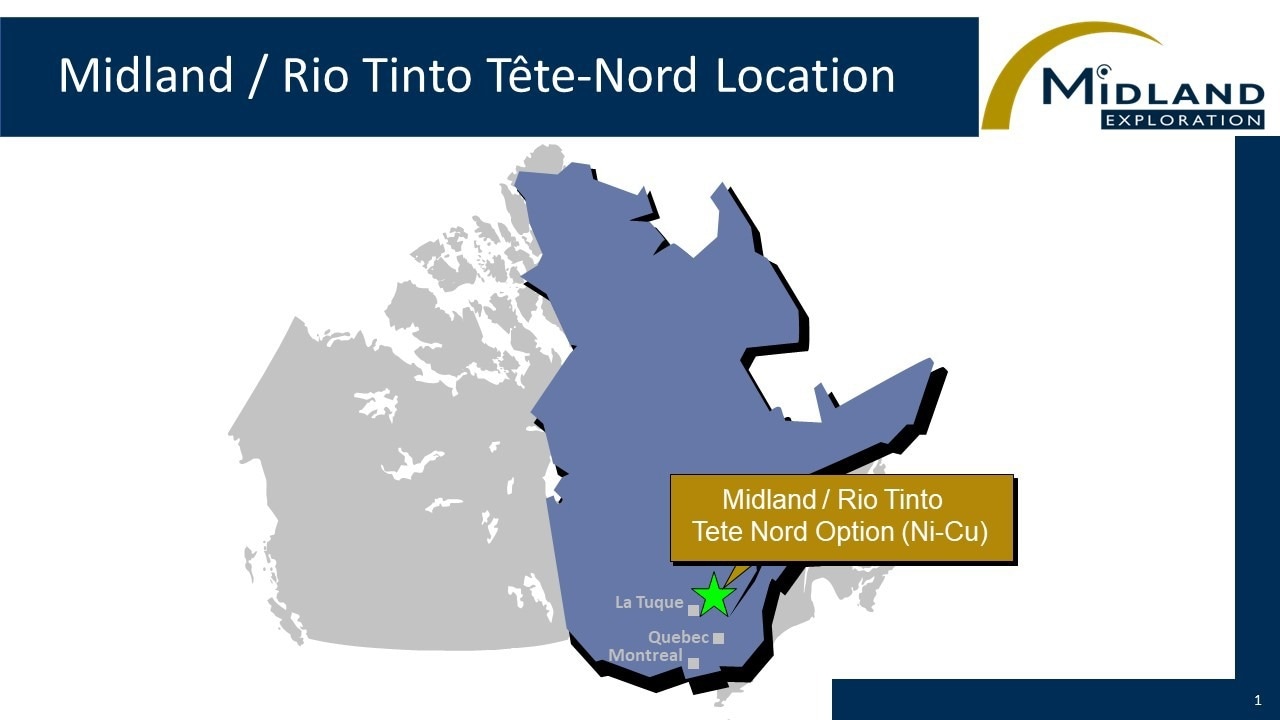Work has resumed at a recent nickel-copper discovery known as Santos by Midland Exploration Inc. On the Tête Nord property, Rio Tinto Exploration Canada Inc.’s initial drilling campaign resulted in the discovery of this zone.
 MD-Rio Tinto Tête-Nord Location. Image Credit: Midland Exploration Inc.
MD-Rio Tinto Tête-Nord Location. Image Credit: Midland Exploration Inc.
New potential geophysical targets near Santos as well as further south, close to the Palmeiras and Savane showings, will be tested as part of an upcoming drilling program.
The Tête Nord property, which is close to the Quebec town of La Tuque, is currently entirely owned by Midland, but since December 2021, it has been covered by an option agreement with RTEC.
Highlights:
- The onset of a new drilling campaign with six drill holes totaling 1,900 m.
- Several additional drilling prospects have been located north of the former Lac Edouard Ni-Cu mine in the Santos and Palmeiras districts.
- New drilling targets at Savane.
New Drilling Targets at Santos and Palmeiras
The previous several months have seen the completion of ground-based gravity investigations near the new Santos Ni-Cu zone and farther south along the same N-S-trending structure, near the Palmeiras showing. The gravity survey resulted in the discovery of fresh potential drilling targets that were advantageously situated close to the two showings.
Depending on the state of the forest fires in this region of Quebec, a fresh drilling campaign with six (6) drill holes totaling up to 1,900 m is expected to start in early July.
Drill hole MDLD0015, part of the maiden drilling program, was used to test a VTEM anomaly and an off-hole anomaly found in drill hole MDLD0009. It intersected numerous strata with Ni-Cu mineralization inside altered gabbro horizons from 14 m to 80 m downhole depth.
The drill hole intersected 1.10% Ni and 0.71% Cu across 2.68 m between 20.11 and 22.79 m. A mineralized zone that extended from 33.02 to 43.39 m farther downgraded 0.45% nickel and 0.18% copper over 10.37 m. This new Santos zone is advantageously positioned in the region along an N-S trending structure, about 8 km north of the previous Lac Edouard Ni-Cu mine.
A new anomaly was discovered a few hundred meters northwest of the Santos zone through modeling of the ground gravity survey conducted this summer in the Santos region. Three (3) drill holes with a combined length of up to 900 m will be finished in the Santos region.
These three drill holes will be collared northwest of Santos to test the new gravity anomaly and investigate two potential south and west extensions of the Santos zone.
A significant gravity anomaly was discovered immediately north of the Palmeiras, about two kilometers south of Santos, following the same N-S-trending structure. Here, mineralized Melagabbro to pyroxenite outcrops was found next to VTEM anomalies.
This new geophysical target will be tested with a single (1) drill hole that can reach a depth of up to 300 m.
Additional Drilling on the Savane Showing
Additionally, a gravity survey was finished in the Savane showing region. A mineralized zone was encountered in drill hole MDLD0001 during the first drilling campaign, grading 1.07% Ni and 0.13% Cu across 0.78 m, from 101.87 to 102.65 m.
By modeling the gravity survey, it was possible to better define the geometry of the mineralized intrusion at Savane and identify two lobes that may have been previously undiscovered portions of the intrusion. To test these intrusive targets, two (2) drill holes with a combined length of up to 700 m will be finished.
A new gravity anomaly similar to the one connected to the mineralized intrusion at the Savane Ni-Cu showing will be explained by prospecting work that will be done about 750 m northwest of the Savane showing.
About the Tête Nord Ni-Cu Property
The former Lac Edouard mine, which once produced 50,000 tonnes of ore grading 1.50% Ni and 0.50% Cu, is located on the Tête Nord property, which is comprised of mafic and ultramafic rocks of the La Bostonnais Complex north of La Tuque.